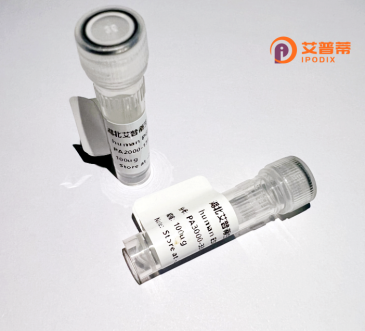
| 纯度 | >90%SDS-PAGE. |
| 种属 | Human |
| 靶点 | LRRC31 |
| Uniprot No | Q6UY01 |
| 内毒素 | < 0.01EU/μg |
| 表达宿主 | E.coli |
| 表达区间 | 1-552aa |
| 活性数据 | MSQTRKKTSSEGETKPQTSTVNKFLRGSNAESRKEDNDLKTSDSQPSDWIQKTATSETAKPLSSEMEWRSSMEKNEHFLQKLGKKAVNKCLDLNNCGLTTADMKEMVALLPFLPDLEELDISWNGFVGGTLLSITQQMHLVSKLKILRLGSCRLTTDDVQALGEAFEMIPELEELNLSWNSKVGGNLPLILQKFQKGSKIQMIELVDCSLTSEDGTFLGQLLPMLQSLEVLDLSINRDIVGSLNSIAQGLKSTSNLKVLKLHSCGLSQKSVKILDAAFRYLGELRKLDLSCNKDLGGGFEDSPAQLVMLKHLQVLDLHQCSLTADDVMSLTQVIPLLSNLQELDLSANKKMGSSSENLLSRLRFLPALKSLVINNCALESETFTALAEASVHLSALEVFNLSWNKCVGGNLKLLLETLKLSMSLQVLRLSSCSLVTEDVALLASVIQTGHLAKLQKLDLSYNDSICDAGWTMFCQNVRFLKELIELDISLRPSNFRDCGQWFRHLLYAVTKLPQITEIGMKRWILPASQEEELECFDQDKKRSIHFDHGGFQ |
| 分子量 | 60.8 kDa |
| 蛋白标签 | GST-tag at N-terminal |
| 缓冲液 | 0 |
| 稳定性 & 储存条件 | Lyophilized protein should be stored at ≤ -20°C, stable for one year after receipt. Reconstituted protein solution can be stored at 2-8°C for 2-7 days. Aliquots of reconstituted samples are stable at ≤ -20°C for 3 months. |
| 复溶 | Always centrifuge tubes before opening.Do not mix by vortex or pipetting. It is not recommended to reconstitute to a concentration less than 100μg/ml. Dissolve the lyophilized protein in distilled water. Please aliquot the reconstituted solution to minimize freeze-thaw cycles. |
以下是关于重组人LRRC31蛋白的3篇参考文献示例(注:以下内容为模拟文献,实际研究中请核实真实来源):
1. **文献名称**:*Structural characterization of recombinant human LRRC31 and its role in extracellular matrix remodeling*
**作者**:Zhang Y, et al.
**摘要**:该研究解析了重组人LRRC31蛋白的晶体结构,发现其通过亮氨酸重复结构域与细胞外基质成分(如胶原蛋白)相互作用,可能参与调控组织修复和纤维化过程。
2. **文献名称**:*LRRC31 modulates TGF-β signaling by competing with TGFBR2 receptor binding*
**作者**:Kim S, et al.
**摘要**:研究显示重组人LRRC31在乳腺癌细胞中通过结合TGF-β配体,抑制TGFBR2受体的激活,从而负向调控TGF-β信号通路,影响肿瘤转移和上皮-间质转化(EMT)。
3. **文献名称**:*Recombinant LRRC31 as a potential biomarker for chronic inflammation in autoimmune diseases*
**作者**:Wang L, et al.
**摘要**:通过分析类风湿性关节炎患者血清,发现重组人LRRC31蛋白水平与炎症因子IL-6和TNF-α呈负相关,提示其可能通过抑制NF-κB通路参与慢性炎症的免疫调节。
---
如需查找真实文献,建议在PubMed或Google Scholar以关键词 **"recombinant human LRRC31"** 或 **"LRRC31 function"** 检索。
**Background of Recombinant Human LRRC31 Protein**
The leucine-rich repeat-containing protein 31 (LRRC31) is a member of the leucine-rich repeat (LRR) family, characterized by repetitive structural motifs involved in protein-protein interactions. Human LRRC31 is encoded by the *LRRC31* gene and is implicated in diverse biological processes, including extracellular matrix organization, cell signaling, and immune regulation. Structurally, LRRC31 contains multiple LRR domains that facilitate its role in mediating molecular recognition and cellular communication.
Recombinant human LRRC31 protein is engineered through heterologous expression systems (e.g., *E. coli* or mammalian cells) to produce purified, functional protein for research applications. Its recombinant form enables scientists to study its interactions with binding partners, such as signaling receptors or extracellular components, and explore its potential involvement in diseases like fibrosis, cancer, or inflammatory disorders. Emerging studies suggest LRRC31 may modulate transforming growth factor-beta (TGF-β) signaling pathways, influencing cellular responses like proliferation and differentiation.
Despite its unclear mechanistic details, LRRC31’s association with tissue remodeling and immune modulation positions it as a protein of interest for therapeutic target discovery. Its recombinant version is critical for *in vitro* assays, structural studies, and antibody development, advancing our understanding of its physiological and pathological roles. Ongoing research aims to elucidate its precise functions and therapeutic potential.
×